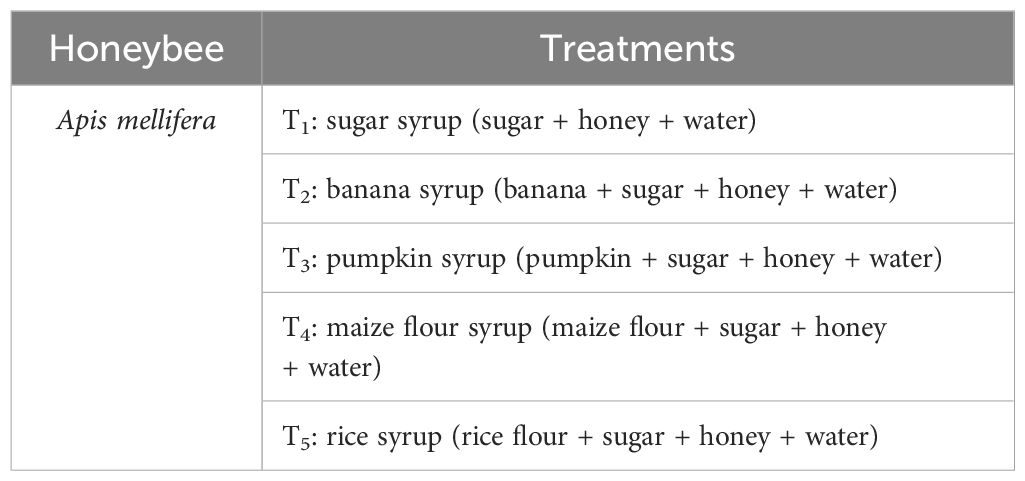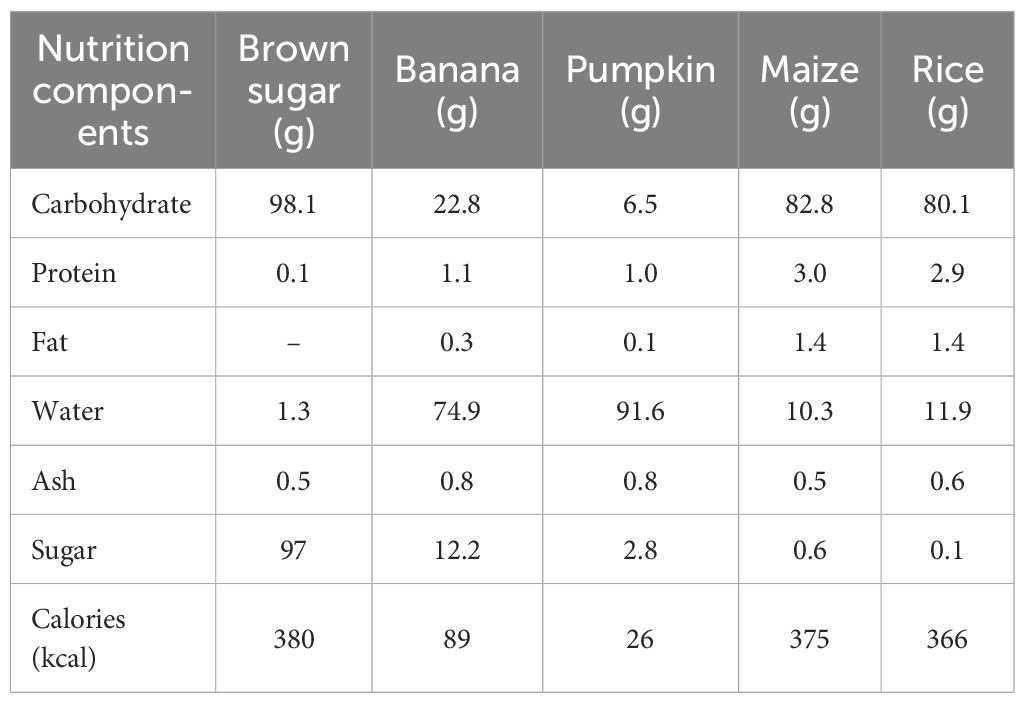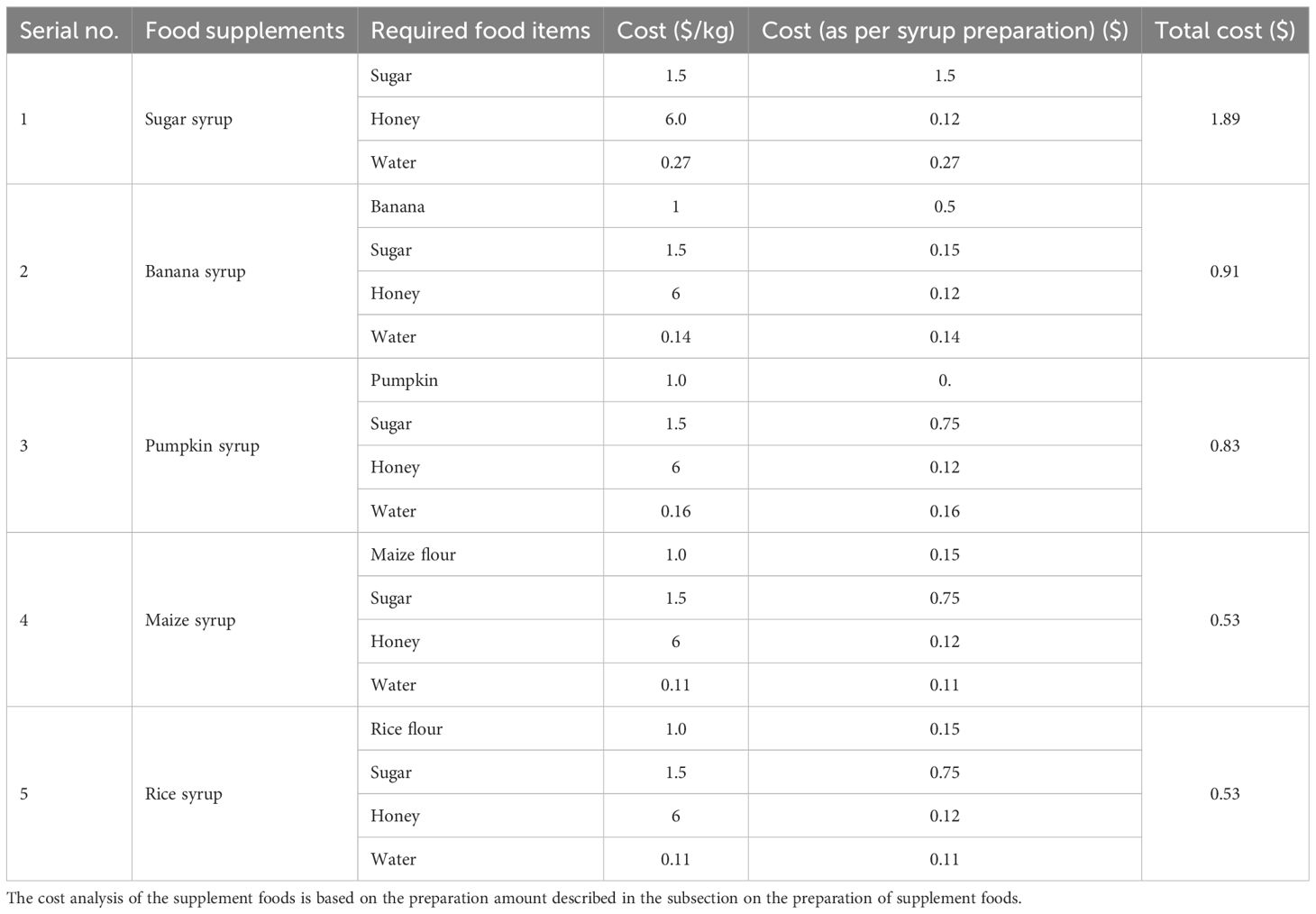- 1Entomology Division, Bangladesh Sugarcrop Research Institute, Ishurdi, Pabna, Bangladesh
- 2Department of Agricultural Extension (DAE), Dhaka, Bangladesh
- 3Agricultural Engineering Division, Pulses Research Center & Regional Agricultural Research Station, Bangladesh Agricultural Research Institute, Ishurdi, Pabna, Bangladesh
- 4Department of Agricultural and Biological Engineering, The Pennsylvania State University, University Park, PA, United States
Sustaining honeybee colonies is challenging during dearth periods as their metabolic functions are reduced due to limited foraging activities. The experiment used honeybee colonies of Apis mellifera, and five different low-cost supplementary foods—sugar, banana, pumpkin, maize flour, and rice flour syrups—were introduced as treatments. Every box for each treatment received a daily 300-ml supplementary food syrup consisting of a specific amount of feeding materials along with 100 g of brown sugar and 20 g of honey. The amount of food consumed was assessed on the second day following the supplementation. Supplemental food with low-cost feeding materials significantly impacts the growth and strength of the colonies. Results revealed significant impacts on colony growth and strength, with all supplements contributing to food consumption over 78%. Despite variations in brood and pollen cells, all feeding supplements showcased efficiency in supporting honeybee feeding, indicating their potential utility in mitigating the challenges during the dearth period. Notably, pumpkin syrup emerged as the best supplement, offering cost-effectiveness compared to sugar and banana syrups, and it could reduce sugar syrup costs by 50% while enhancing brood, honey, and pollen cell production by 71.36%, 108.36%, and 58.73%, respectively. The findings of the economic analysis revealed that the cost of feeding materials was the highest for sugar syrup ($1.89), followed by banana ($0.91), pumpkin ($0.83), maize ($0.53), and rice ($0.53). This study suggests that supplementing honeybee colonies with low-cost feeding materials can positively impact colony growth and strength during dearth periods and advance the beekeeper’s decision as a cost-effective alternative to traditional sugar syrup.
1 Introduction
Honeybees play a crucial role as beneficial insects, collecting nectar and pollen to produce honey and serving as pollinators to enhance crop productivity. A shortage of bees would impede the harvesting of these valuable resources (Jovanovic et al., 2021). Moreover, various factors, such as habitat loss, predators, parasites, diseases, pesticide exposure, and climate change, have an adverse impact on bee populations in their colonies (Mull et al., 2022). The foraging dynamics of honeybees play a crucial role in sustaining populations and ensuring the growth of their colonies during their dearth period (Russell et al., 2013; Colin et al., 2022). Furthermore, the honeybee colony’s growth and development depend on sufficient food availability (Harris, 2023). At present, beekeeping has become famous in many developing countries and acts as an employment source.
The effectiveness of beekeeping depends on the abundance of bee-friendly flora in the surrounding area of the apiary, taking into account various climate circumstances, and the availability or ease of access to bee-friendly flora varies across different seasons in specific regions. The period of the year when there is a lack of flora that attracts bees is referred to as the dearth period (Döke et al., 2015; Shitaneh et al., 2022). The limited availability of bee flora and inadequate food stores inside honeybee colonies negatively impact the brood’s rearing, the production of honey, and the overall growth and development of the colony (Shitaneh et al., 2022). Different diseases and pest populations were also infested at this time. A healthy food chart should be ensured to make the bee colony stronger and more productive. For this reason, they need food supplements during the dearth period, and it is essential to provide honeybee colonies with pollen substitutes or food supplements during periods of dearth to ensure future honey production (Khan and Ghramh, 2022; Khan et al., 2023).
Honeybees can visit diverse food sources at the same time and travel a distance of approximately 10 km to acquire essential food resources, including nectar and pollen. These resources, such as honey and beebread, are stored in their colonies. Nectar is the primary source of carbohydrates needed to fulfill energy needs (Brodschneider and Crailsheim, 2010). Honeybees get both macro and micronutrients from pollen, such as proteins, minerals, vitamins, and lipids, which are necessary for several aspects of their development, including brood rearing, maturity, adult lifespan, and overall colony growth (Wright et al., 2018). The diversity of plant species directly affects the fatty acid levels and nutritional components of pollen, significantly impacting honeybees’ strength (Leponiemi et al., 2023). Notably, the nutritional value of pollen can be more accurately determined by its amino acid composition rather than its total protein level, as its nutritional value decreases when there is an insufficient amount of necessary amino acids (Jeannerod et al., 2022).
Supplementary food’s nutritional facts are crucial for honeybee’s optimal health and growth (El Ghouizi et al., 2023). Researchers stated that honeybees can use complex carbohydrates, which are crucial for their role as food processors in honeybee colonies (Hrassnigg and Crailsheim, 2005). According to feeding tests conducted on different carbohydrates, it has been determined that sucrose (consisting of 2 parts sugar and 1 part water) is the most suitable carbohydrate supplement for honeybees. In spring, honeybee colonies that were fed with various stimulating diets exhibited an approximate 6% increase in the brood population (Paray et al., 2021). Utilizing sugar syrup, pollen supplement, or a combination of both is advantageous during periods of dearth to cultivate larger foragers, hence maximizing the honey yield (Paray et al., 2021).
Honeybees receive nutrients from nectar and pollen; honey is produced through the bee’s enzymatic conversion of nectar (Paray et al., 2021). However, maintaining honeybee colonies is a significant problem due to the lack of natural flora, nectar, and pollen during the dearth period (July–September) (Döke et al., 2015). In adverse circumstances characterized by limited availability of pollen and nectar, the utilization of pollen or food supplements effectively sustained the strength of the colony during the period of dearth. Additionally, these supplements facilitated the enhancement of the colony’s brood strength, as one would expect (Gemeda, 2014). According to the research, sugar syrup was used as a positive control of supplementary food and fed internally as conventional feeding. Day by day, sugar prices are increasing, making beekeeping expensive.
Scientists globally have developed artificial diet formulations for honeybees, taking into account their specific nutritional needs for pollen and honey, with the aim of improving overall colony strength. A multitude of diet formulas has been created by blending different substances, such as soybean flour, soya flour, parched gram, brewer’s yeast, guar meal, egg yolk powder, pea powder, skimmed milk powder, protein hydrolysate powder, casein, fish meal, and rice bran (Paray et al., 2021; Basu et al., 2024). However, while these supplements have shown varying degrees of efficacy, there remains a need for further exploration to identify optimal suitable supplementary food for bee colonies during periods of limited forage availability. Hence, it is crucial to supply honeybee colonies with food substitutions to ensure their survival and growth. The supply of food supplementation can be assessed by evaluating factors such as reproductive efficiency, resistance to diseases, increase in honey weight, and dietary intake or by measuring the size of worker broods (Ricigliano et al., 2022; McMenamin et al., 2023).
This novel study aims to add to the existing body of knowledge by analyzing the acceptability of four plant flour syrups, namely, banana, maize, pumpkin, and rice, as viable supplements for off-season bee diets. Despite the wide range of supplements commonly used in beekeeping, our choice of these specific flours is based on their relatively unexplored potential in the field of examining cost-effective carbohydrate bee supplementation. To the best of our current understanding, there is a lack of comprehensive investigation or use of these flours as bee supplements in previous studies. Hence, the present study aims to address this research gap by evaluating the nutritional composition and possible effects of these novel sources on the development of brood, honey, and pollen cells. Therefore, the study was undertaken to find the appropriate combination of food supplements in the off-season to enhance the range of supplementary food alternatives accessible to beekeepers, therefore equipping them with supplementary resources to enhance colony strength and production while reducing the total cost of beekeeping during the dearth period and keeping bees more viable.
2 Materials and methods
2.1 Experimental site, climate, and design
The experimental study was conducted at the apiary laboratory of Bangladesh Sugarcrop Research Institute (BSRI), located in Ishurdi, Pabna, Bangladesh, during the dearth period of July to September 2021–2022 and 2022–2023. The climate of the experimental site is classified under the Köppen climate classification system as having a predominantly tropical monsoon climate, specifically designated as Am (Farukh et al., 2023). This classification indicates a region with a hot, dry, and humid climate, where there is heavy rainfall during the rainy season from July to September. The average rainfall is 17.94 mm (avg.), and the temperature is 31.44°C (avg.) (BSRI weather station). Bangladesh boasts a rich variety of local flora, including thriving forests, mangrove swamps, and extensive wetlands. However, during the dearth period from July to September, honeybees in Bangladesh encounter considerable difficulties due to food shortages. This period aligns with the monsoon season, characterized by a decrease in floral resources caused by heavy rainfall. There were seasonal gaps in food availability for honeybees during this time, and they faced challenges when it comes to finding enough food. These challenges include diminished flowering of plant species, damage to flowers and loss of nectar and pollen due to flooding, limited floral diversity in agricultural areas, and loss of habitat due to deforestation and urbanization. In order to tackle these challenges, beekeepers might have to consider providing supplementary food.
The experiment was conducted on the honeybee species Apis mellifera. The experimental design chosen was a randomized complete block design (RCBD) with five replicates for each treatment, as shown in Table 1, where sugar syrup was used as a control treatment. The honeybees of A. mellifera colonies were taken for treatment from the BSRI apiary, Ishurdi, Pabna.
2.2 Preparation of supplementary foods
An assortment of food supplements was developed and supplied to honeybee colonies, with subsequent monitoring of their growth and consumption of food. Various syrups have been developed using sugar, banana, pumpkin, maize flour, and rice flour to provide an alternate food source for honeybees during a dearth period. The following outlines the preparation techniques for these food substitutes:
2.2.1 Sugar syrup
The brown sugar obtained from the BSRI processing facility had a mass of 1,000 g, and it had been thoroughly mixed with 1 L of fresh water. Next, the mixer was heated to a temperature of 100°C to facilitate the crystal sugar’s dissolution. Subsequently, the mixer was allowed to cool. Twenty grams of honey was added into it and a sugar syrup with a volume of 900 ml was prepared. Each box was provided with 300 ml of sugar syrup as a substitute for the food diet. Stick pieces were placed on the feeding material to provide a stable surface for honeybees to sit on and consume their food.
2.2.2 Banana syrup
Ripe Shobri banana (Musa acuminata, Musa balbisiana AAB Group, variety: Onupam) was peeled, crushed, and measured, resulting in a weight of 500 g. An additional 500 ml of fresh water was introduced to it. Subsequently, it was mixed together. Ultimately, the solution was prepared by dissolving 100 g of crystal sugar and 20 g of honey. This solution was to increase volume up to 900 ml with the addition of fresh water. Each box was provided with 300 ml of banana syrup as a food substitute. A cloth net was positioned above the food source to prevent the honeybee from dying during its consumption. Some pieces of stick were provided over the feeding material to support honeybees in feeding comfortably. Figures 1A, B show the preparation materials for the banana syrup and placing banana syrup over the cloth net and stick, respectively.
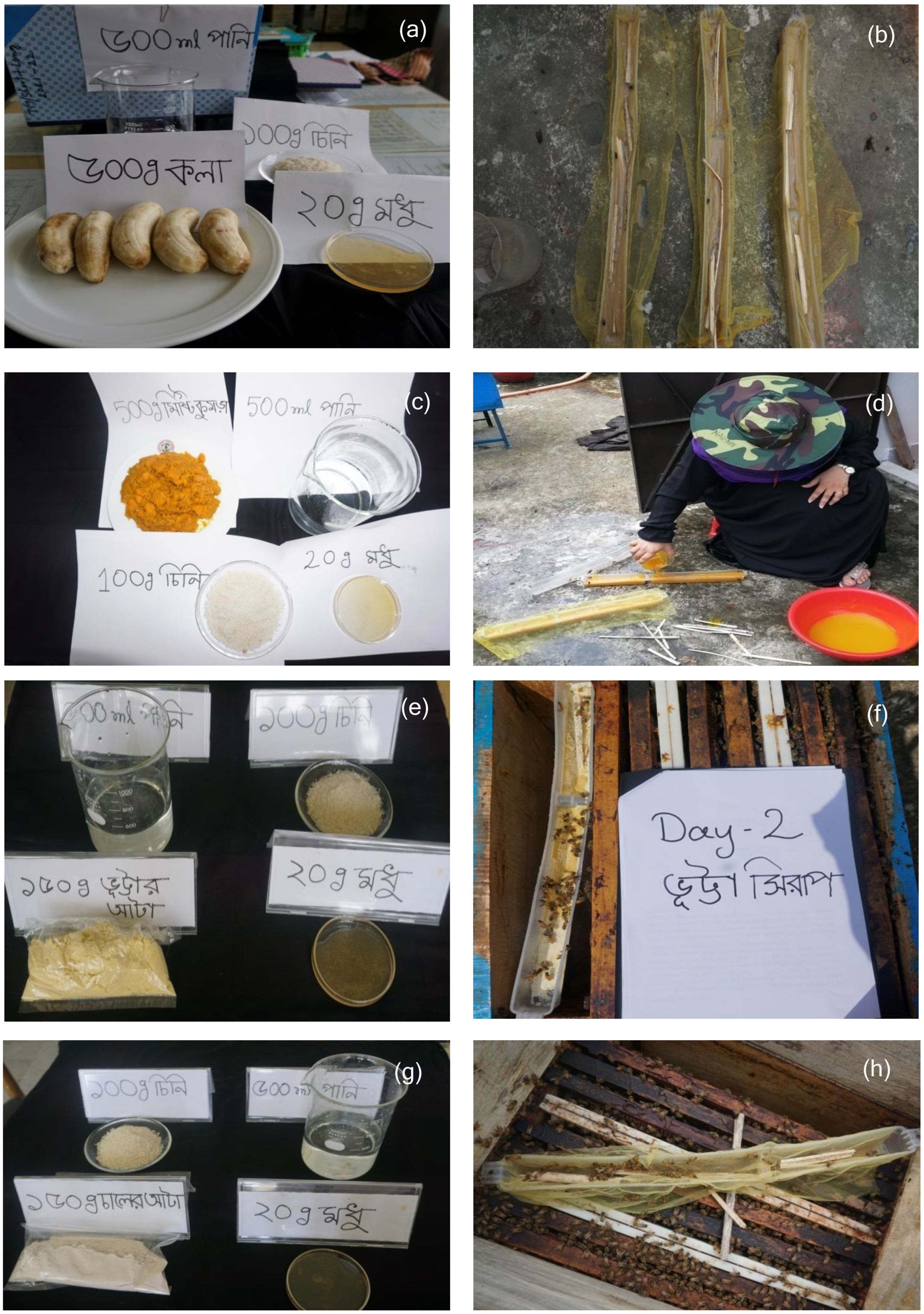
Figure 1. Preparation of different food substitutes: (A) banana syrup materials, (B) cloth net and banana syrup over the stick, (C) pumpkin syrup materials, (D) putting cloth net and sticks on the pumpkin syrup, (E) maize flour syrup materials, (F) condition of maize flour syrup after consumption, (G) rice flour syrup materials, and (H) cloth net and stick were used over food substitutes.
2.2.3 Pumpkin syrup
A ripe pumpkin (Cucurbita pepo, variety: BARI Mistikumra-2) was peeled, and its weight was measured at 400 g. The material was boiled in water and subsequently cooled. The mixture was pulverized and blended, and 600 ml of fresh water was added. Subsequently, it was mixed together. Ultimately, the solution was prepared by dissolving 100 g of crystal sugar and 20 g of honey. The proposed method involved augmenting the volume to 900 ml by incorporating additional fresh water. Each box was provided with 300 ml of pumpkin syrup as a food substitute. Some stick pieces were positioned above the food source to prevent the honeybee from dying during its consumption and it could feed on it comfortably. Figures 1C, D show preparation materials for the pumpkin syrup and putting cloth net and sticks on the pumpkin syrup, respectively.
2.2.4 Maize syrup
The weight of the maize flour (Zea mays, variety: Barnali) was 150 g, and it was soaked in 400 ml of water for 2 h. Then, it was mixed together. A solution was prepared by dissolving 100 g of crystal sugar and 20 g of honey. The proposed method was adding fresh water to increase the volume to 900 ml. Every box was provided with 300 ml of maize syrup as a substitute for food. A cloth net was positioned above the food source to prevent the honeybee from dying during its consumption. Several stick pieces were placed on the feeding material to provide a stable surface for honeybees to sit on and consume food. Figures 1E, F show the preparation materials for the maize syrup and the condition of the maize flour syrup after consumption, respectively.
2.2.5 Rice syrup
The weight of the rice flour (Oryza sativa, variety: BRRI dhan29) was 150 g, and it was soaked in 400 ml of water for 2 h. Then, it was mixed together. A solution was prepared by dissolving 100 g of crystal sugar and 20 g of honey. The proposed method was to increase the volume to 900 ml with the addition of fresh water. Every box was provided with 300 ml of maize syrup as a substitute for food. A cloth net was positioned above the food source to prevent the honeybee from dying during its consumption. Several stick pieces were placed on the feeding material to provide a stable surface for honeybees to sit on and consume food. Figures 1G, H show the preparation materials for the rice flour syrup and placing rice syrup over the cloth net and stick, respectively.
2.3 Supplementary food’s nutritional analysis
The nutritional data of the supplementary food were typically measured by laboratory analysis of representative samples of the food supplements. This analysis includes measuring macronutrients (such as carbohydrates, proteins, and fats) and other components like fiber and moisture. A bomb calorimeter was used to measure the heat of combustion of the used food supplements, providing information on the total caloric content, where the specific bomb calorimeter calibration method (i.e., benzoic acid) was used (Hopper et al., 2023). Proximate analysis is a set of procedures to determine a food material’s approximate or proximate chemical composition—the components typically analyzed include moisture, ash (minerals), lipids (fats), proteins, and carbohydrates. In order to measure the moisture content, the gravimetric method involves drying the sample and measuring the weight loss (Farias et al., 2022). The method of incineration of the food sample to combust organic matter, leaving behind the inorganic ash, the muffle furnace (PCMF-1) instrument, was used to determine the ash content of food materials (PACORR, 2023). The instrument solvent extractor was used to measure the lipid (fat) content by using the solvent extraction method (Hewavitharana et al., 2020). The Kjeldahl method was introduced to determine the protein content, which involves the digestion of food supplementation with a strong acid so that nitrogen can be released, the quantification of the protein by a titration procedure, and the multiplication of total nitrogen in the food supplementation with a traditional conversion factor of 6.25 for brown sugar, banana, and pumpkin and a species-specific conversion factor of 5.4 for maize and rice flours, as described elsewhere (Mæhre et al., 2018). The indirect method was employed to measure the carbohydrate content by calculating the difference (100% − sum of moisture, ash, lipids, and protein) of the specific food materials. Following the homogenized sample’s water extraction, sugars (mono- and disaccharides: fructose, glucose, sucrose, and maltose) were measured using liquid chromatography (AOAC 980.13) (AOAC, 2005; Phillips et al., 2021). These methods are standard procedures and have variations based on the specific requirements of the analysis and the characteristics of the food materials. The choice of method depends on factors such as the nature of the food, the precision required, and the available resources in a laboratory setting. The accuracy of the labels depends on various factors, including the accuracy of the laboratory analysis, the manufacturing process, and the regulations in place. However, there can still be variations in the actual nutritional content of individual items due to factors like natural variation in agricultural products and manufacturing processes (Chen and Antonelli, 2020). Table 2 shows the nutritional contents of the different feeding materials used in this study.
2.4 Data collection and analysis
The total quantity of food consumed by honeybees was quantified to determine the preferred food supplements for honeybees. The remaining supplies were counted the day after providing the food (24 h later). Food consumption was determined by subtracting the initial food supply from the remaining food. Three boxes for each treatment containing bee colonies were put together, each equipped with queens of similar levels. Each of these three treatment colonies was allocated to a specific feeding treatment using the same feeder. Every box contained 300 ml of food substitutes. Data collection involved extracting two sides of a single frame from each box. The first data were collected before the feeding material was provided. Additional data were obtained every second day to evaluate the influence of honeybee colonies on these food sources during a week. Pictures of bee frames were captured, and the number of brood, honey, and pollen cells was determined by counting the images with the naked eye.
Statistical analysis of various treatments was conducted using the ‘R’ Studio (Team, R.D.C, 2019). Analysis of variance (ANOVA) tests were used to detect significant differences (at a significance level of α = 0.05) within treatments. The means were compared using the least significant difference (LSD) test at a significance threshold of 5%. Cost analysis involves calculating the expenses associated with acquiring various food supplements, comparing the result benefits in terms of productivity, and identifying the most economical option. This assessment considers factors such as the cost per unit of each supplement, its effectiveness in supporting colony growth, and potential long-term cost-effective savings in honeybee maintenance.
3 Results and discussion
3.1 Supplementary foods performance on honeybee colonies
Table 3 shows the comparative assessment of daily supplementary food consumption in honeybee colonies during the dearth period. Without question, sugar is the preferred food in the diet of honeybees. The results show that the brown sugar syrup used in this experiment contains 97 g sugar out of 100 g, whereas the honeybee colonies consumed 100% sugar syrup. One hundred grams of banana syrup has 12.2 g of sugar, whereas pumpkin contains 2.8 g of sugar. That is why honeybees have a higher preference for consuming banana syrup (93.96%) than pumpkin syrup (88.30%) in food consumption competition, as shown in Table 3. It can be seen from Table 2 that maize and rice have a minimal sugar content of 0.6 g and 0.1 g, respectively. Therefore, the food consumption ratio of these two items is lower than that of the other three items, which are 85.07% and 78.41%, respectively. Based on the findings in Table 3, it appears that honeybees have a clear preference for banana, pumpkin, maize flour, and rice flour syrup, in that particular order. The amount of syrup consumed by honeybee colonies can vary depending on the type of syrup provided. For example, researchers presented that honeybees might have a preference for banana and pumpkin syrups because of the natural sugars and unique flavors they make available, resulting in honeybees consuming more of these syrups compared to rice and maize flour syrups (Neupane and Thapa, 2005). Nevertheless, honeybees might still consume rice and maize flour syrups, particularly when it is fermented.
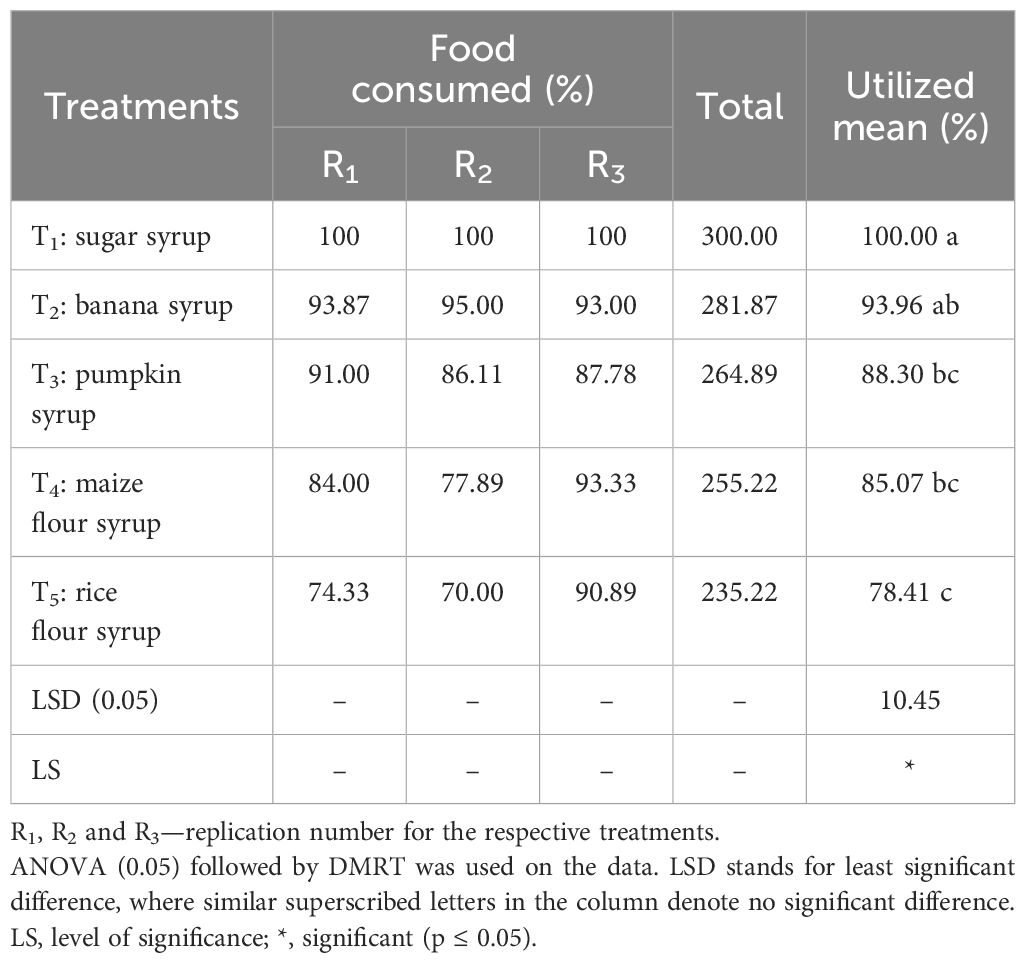
Table 3. Comparative analysis of supplementary food consumption per day in honeybee colonies during a dearth period.
Fermentation can improve the taste by improving flavor quality and nutritional content although the amount consumed could differ. It was observed from the study that the fermentation process of rice and maize flour syrups began approximately 24 h after feeding, while the fermentation of banana and pumpkin syrups started approximately 36–48 h after feeding. It was also noted that the supplement syrups were consumed within 48 h, which counted for the analysis. When the honeybees consume supplementary food, they introduce it into their hives, which undergo a natural fermentation process due to the enzymes and microorganisms in the hive environment. It is interesting to note that bees prefer fermented foods over fresh foods due to their higher energy value and the aromatic compounds that they produce that could attract bees to the syrup. In addition, fermentation duration may extend beyond 24 h, particularly in situations where conditions are conducive to microbiological activity. However, availability, colony health, and environmental conditions all contribute to the variations in supplementary syrup consumption among honeybee colonies (Margaoan et al., 2020; Camacho-Bernal et al., 2021). It is essential to acknowledge that the exact time and duration of fermentation may exhibit variability dependent upon various environmental factors, including temperature, humidity, pH level, specific strains of microorganisms, and the specific composition of the supplement flours. For this study, warmer temperatures and higher humidity levels during the dearth period could enhance fermentation.
3.2 Impact of supplementary foods on pollen cell development
The number of pollen cell development in honeybee colonies during the dearth period was measured while providing various supplementary foods, as shown in Table 4. According to the findings, the number of cells covered with pollen after each treatment decreased, except for the pumpkin syrup. The colony was provided with pumpkin syrup, resulting in a significant increase in the number of pollen cells (58.73%). On the other hand, the consumption of sugar syrup resulted in a decline of 21.97% in pollen cells. In the same way, the consumption of maize syrup led to a 53.25% reduction in pollen cells, whereas rice syrup caused an even more significant decrease of 73.61%. The colony which consumed banana syrup exhibited the most significant decrease (81.98%) in pollen cells.
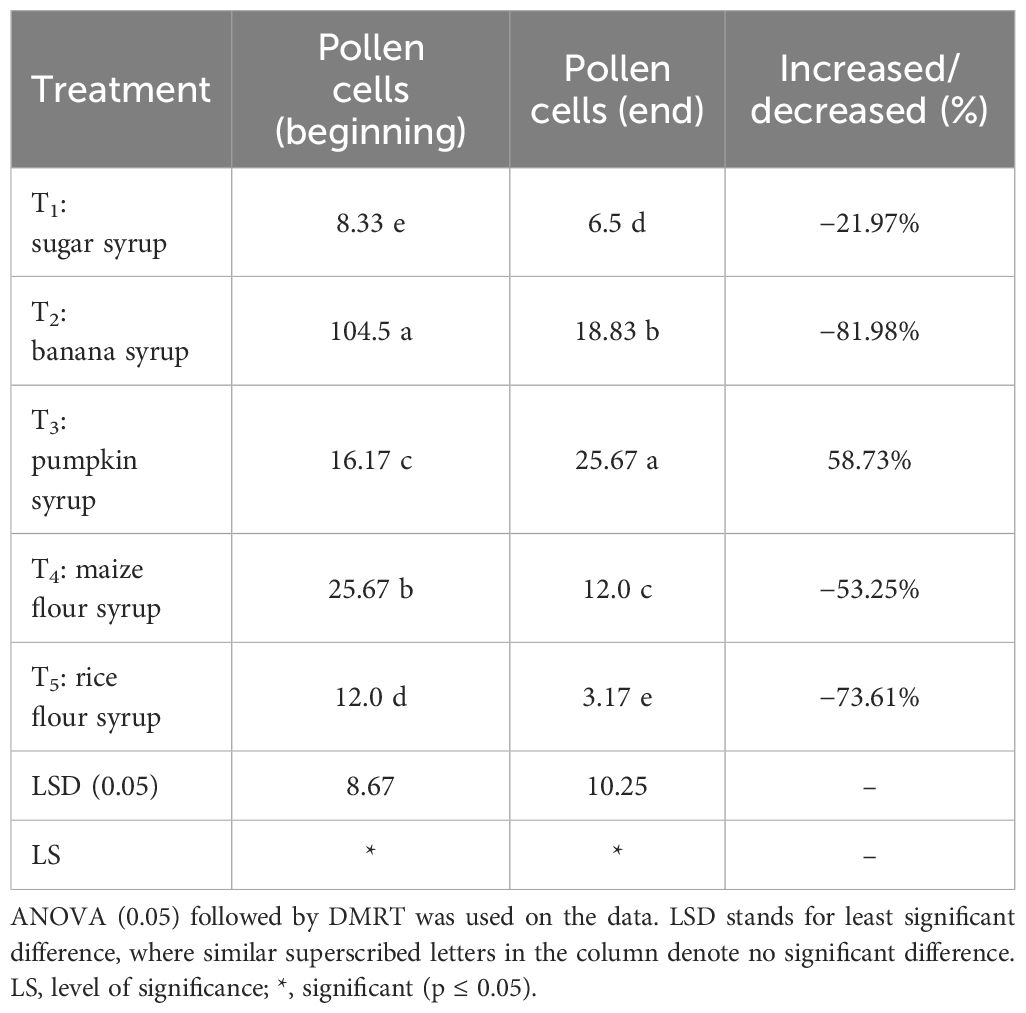
Table 4. The number of pollen cells on honeybee colonies during the dearth period for feeding of the different food supplements.
The supplementary foods could have an impact on the pollen cell development in honeybee colonies by providing additional nutrients necessary for pollen collection and storage. Pollen serves as a crucial protein source for developing brood and the overall health of the colony. Protein and carbs are the primary constituents for developing honeybee pollen cells (Khalifa et al., 2021). According to the findings, pumpkin has an ideal protein and carbs ratio conducive to pollen growth (Table 2), and consuming pumpkin syrup leads to a rise in pollen cells. However, pumpkin syrup, which is rich in sugars and micronutrients, has the potential to attract bees to forage more actively, resulting in an increased pollen collection that aids in the growth of pollen cells. Pollen cell development ensures the availability of sufficient pollen resources within the hive, promoting the growth and vitality of the colony’s production.
3.3 Impact of supplementary foods on the brood cell development
The study investigates the variation in the number of brood cell development in honeybee colonies when provided with different food substitutes during a dearth period (Table 5). The findings indicate that the number of brood cell development varied after feeding several types of food substitutes. It was observed that bee colonies that received pumpkin syrup showed a significant increase of 71.36% in the number of brood cells. Colony growth was observed as brood cells developed, with a notable increase of 37.58% in colonies fed with banana syrup. Conversely, colonies fed with rice syrup showed a slight loss of 0.33% in brood cells, while those fed with maize syrup had a more significant decrease of 49.66%. The sugar syrup exhibited the lowest number of brood cells, with a drop of 69.48% compared to other conditions, as seen in Table 5. Researchers find that feeding a protein-rich diet significantly positively affects the number of bees present on frames (Ricigliano et al., 2022).
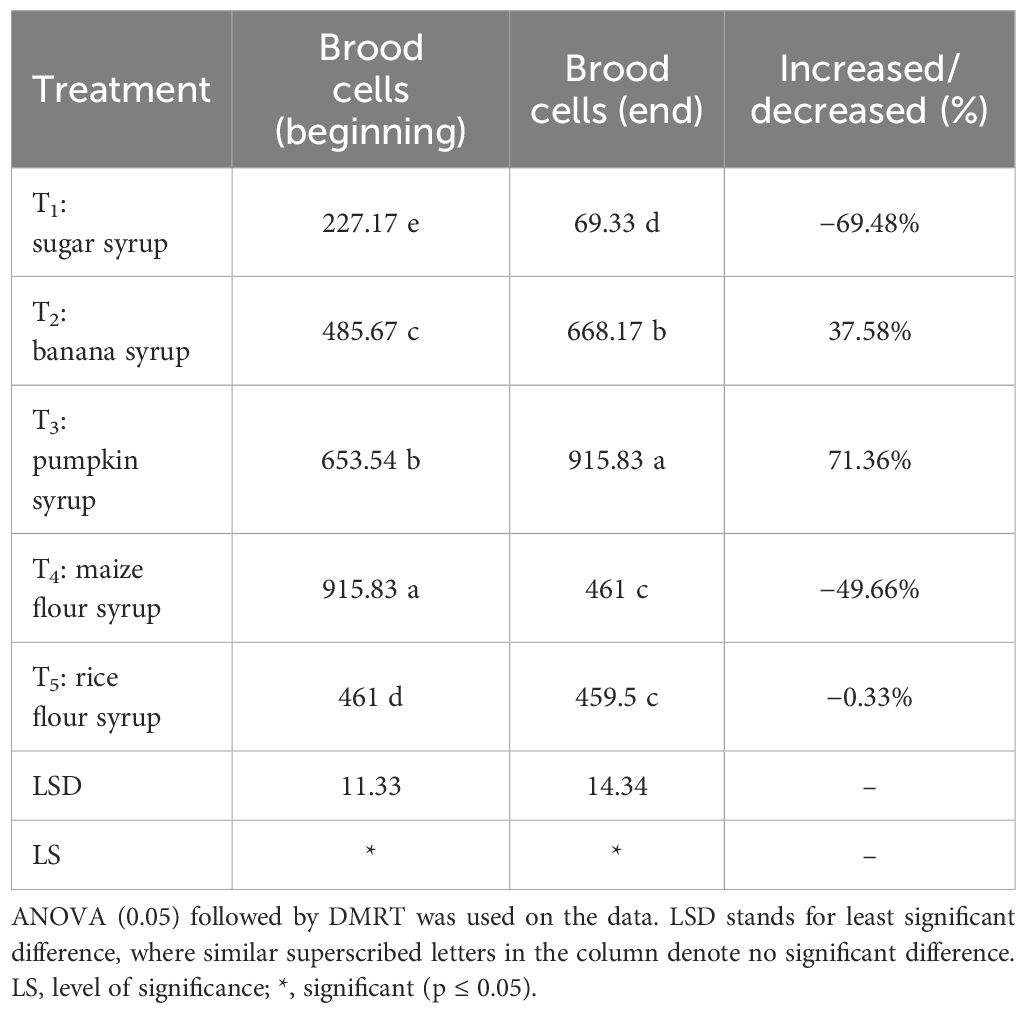
Table 5. The number of brood cells on honeybee colonies in the dearth period for providing different artificial food substitutes.
The impact of supplementary food with banana, pumpkin, maize flour, and rice flour syrups on the growth of brood cells in honeybee colonies could vary based on the specific nutrient composition of each syrup. Carbohydrates, protein, and fat are essential components for optimal brood cell growth of honeybee colonies. The banana and pumpkin syrups are known for their high levels of natural sugars and nutrients. The study revealed that both bananas and pumpkins are good sources of protein and carb ratios (Table 2). These syrups have been found to positively impact brood cell development, resulting in higher brood production and faster development. Although the maize and rice flour syrups do provide more carbohydrates, the food consumption rate of these syrups was lower, resulting in these syrups not having all the essential nutrients needed for optimal growth. Therefore, it is crucial to carefully consider the food consumption of each syrup, ensuring proper nutrition and effectively managing supplementary food in order to promote brood cell development and maintain the sustainable health growth of the colony.
3.4 Impact of supplementary foods on honey cell development
Supplementary food such as banana, pumpkin, maize flour, and rice flour syrups during the dearth period significantly impacts honey cell development in honeybee colonies. Table 6 shows the development of honey cells in honeybee colonies when provided with different supplementary food alternatives during the dearth periods. The honey cell numbers exhibited a somewhat uniform appearance at the start of the experiment and then varied after providing various types of food substitutes. Upon concluding the experiment, it was noted that the bee colonies that were given pumpkin syrup displayed the highest number of honey cells, showing a significant increase of 108.36%. Next, colonies were given sugar syrup as supplementary food, resulting in a 5.37% increase. Conversely, colonies fed with banana syrup experienced a decrease of 4.18% in honey cells, while those fed with maize syrup showed a decrease of 8.96%. The lowest number of honey cells was found in colonies fed with rice syrup, with a decline of 48.69%, as shown in Table 6.
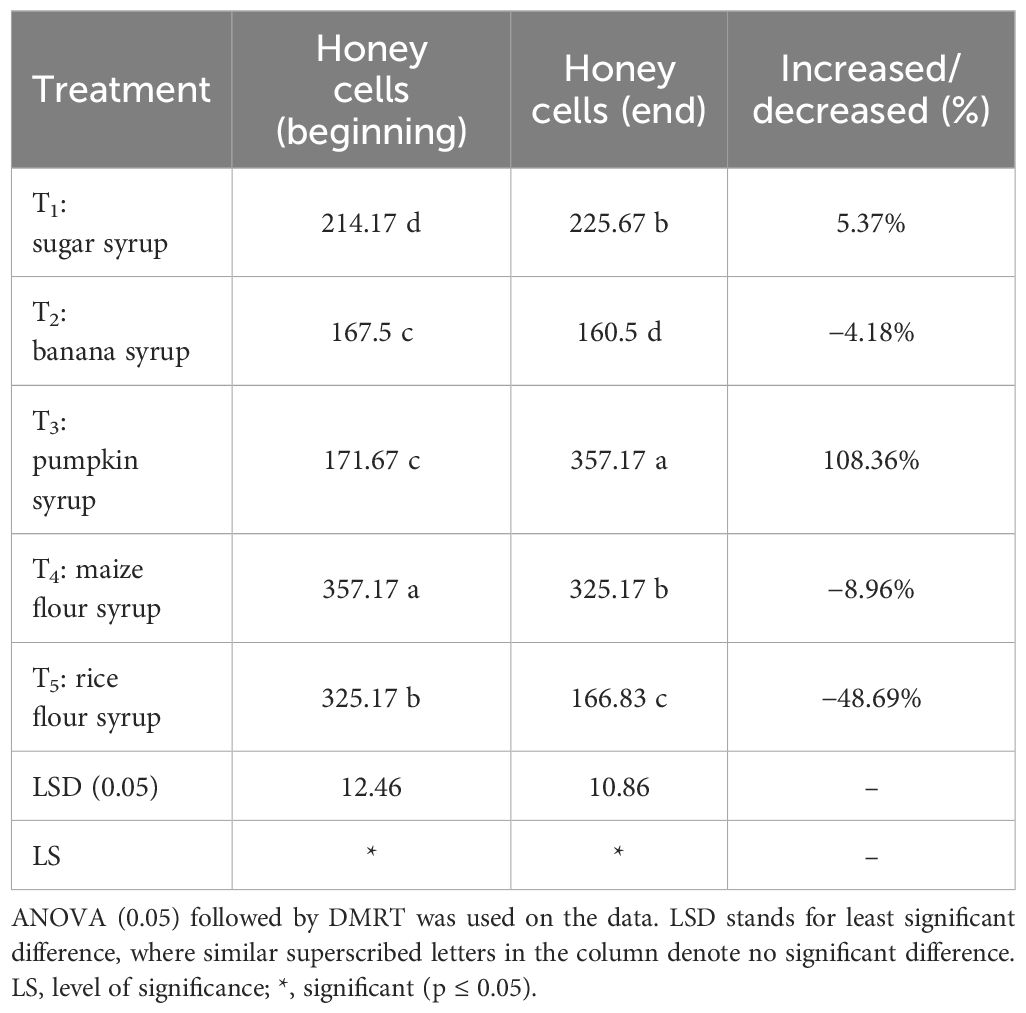
Table 6. The development of honey cells in honeybee colonies fed with various artificial food substitutes during periods of dearth.
Banana and pumpkin syrups, being naturally rich in sugar, water and potentially other nutrients, can provide a boost to honey cell development, promoting increased honey storage within the hive. However, primarily, carbohydrate sources, maize flour, and rice flour syrups can also contribute to honey cell development by providing energy for wax production and maintenance of hive infrastructure. However, the decrease in honey cells, even with the addition of maize flour and rice flour syrups to honeybee colonies, may be due to a deficiency in essential nutrients and an unbalanced carbohydrate composition in these syrups (Samukelisiwe, 2023). Maize flour and rice flour syrups mainly offer carbohydrates but may not contain the wide range of sugar and water needed for optimal honey cell development to reach their full potential.
3.5 Comparative analysis of pollen, honey, and brood cell development during the dearth period
Figure 2 shows the comparative analysis of the brood, honey, and pollen cell numbers before and after the consumption of supplementary food in the dearth period from honeybee colonies. The development of brood cell numbers is increased only for the banana and pumpkin syrups. On the other hand, brood cell numbers are decreased for the other three syrups. Honeybee colonies that were given pumpkin syrup experienced a greater rise in brood and bee populations than those that were given banana, maize, or rice flour syrup. Thus, pumpkin and banana syrups surpass rice flour in terms of quality. Additionally, maize flour can be a cost-effective alternative for feeding bee colonies during the off-season, enhancing their viability. The results reveal that pumpkin supplementary food increased the population density compared to all supplemented foods. Honey and pollen cells also increased significantly in those bee colonies fed on supplemental pumpkin syrup. The figures also underline that all supplemental food tests here were not equally effective in stimulating the various biological activities of honeybee colonies. This analysis allows for a comprehensive assessment of how the introduction of supplemental food influences the development and resource allocation within honeybee colonies over time.
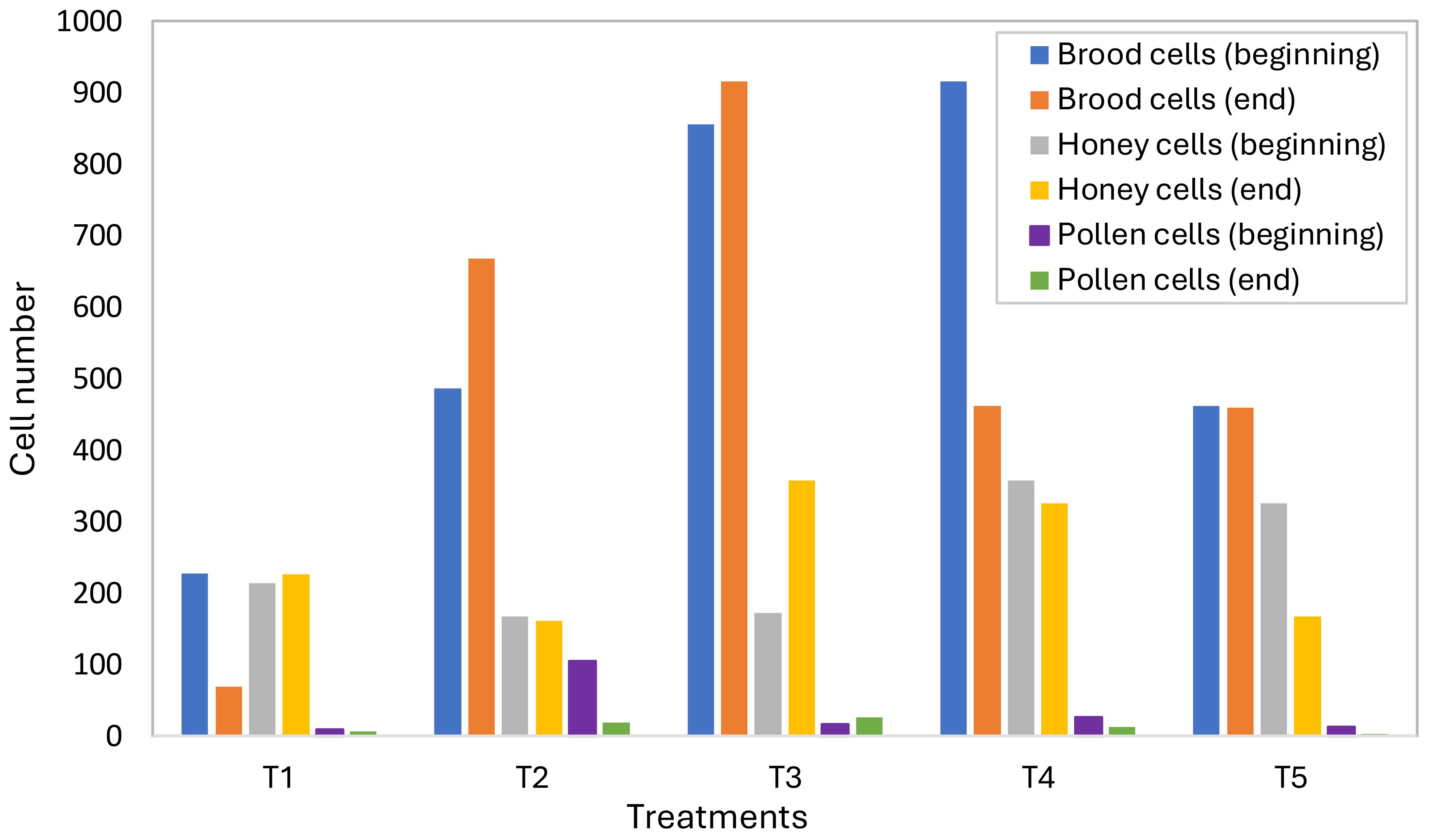
Figure 2. The brood, honey, and pollen cell numbers are represented before and after the consumption of the supplementary food in the dearth period. T1: sugar syrup, T2: banana syrup, T3: pumpkin syrup, T4: maize flour syrup, and T5: rice flour syrup.
Figure 3 shows the comparative percentage of pollen, honey, and brood cell numbers after taking the supplementary food in the dearth period. The figure underlines that brood, honey, and pollen cell percentages are increased only for the pumpkin syrup. It can be noted that wherever the feeding supplementary foods contain low carbs and high sugar, the honeybee most likely prefers to consume those supplementary foods in the dearth period, resulting in an increase in the development of brood, honey, and pollen cells in arid or semi-arid hot climate environment during the dearth period. The sugar and water are essential components for forming honeybee honey cells (Table 2). Pumpkin syrup has these components in an optimal amount. Therefore, consumption of pumpkin syrup leads to an increase in honey cell numbers. Due to the lower water content in banana syrup compared to pumpkin, the honey cell experiences a minor drop in size after its uptake. Due to the low sugar content in maize and rice syrups, the intake of these syrups in honeybees decreased. Consequently, there is a decrease in the production of brood, pollen, and honey cells.
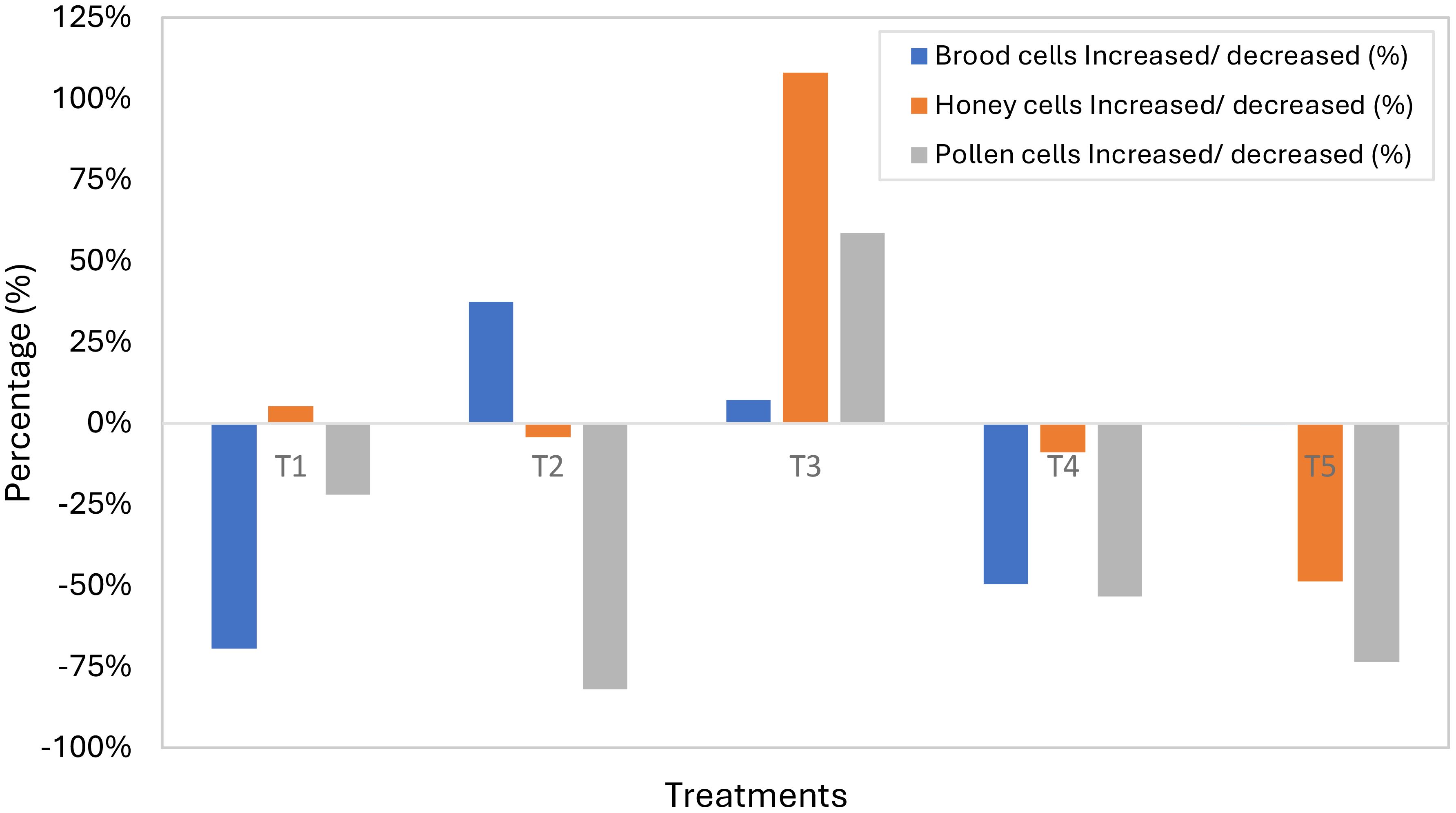
Figure 3. The comparative percentage figure of pollen, honey, and brood cell numbers after taking the supplementary food materials in the dearth period. T1: sugar syrup, T2: banana syrup, T3: pumpkin syrup, T4: maize flour syrup, and T5: rice flour syrup.
The nutrition of honeybees encompasses a diverse array of chemical compounds, including carbohydrates, lipids (fat), proteins, minerals, and vitamins. During the dearth period, there is a wide availability of fruits, vegetables, and cereals in the market that are abundant in carbs, proteins, vitamins, and minerals. These nutritious options may be obtained at a lower cost and can serve as suitable alternatives for feeding bees during this period. Among these, banana and pumpkin are both the most affordable and the most nutritious fruits compared to others (Table 2). Feeding bees with banana and pumpkin syrups offers energy and provides protein, vitamins, minerals, and sugar in a certain amount, resulting in increased tissue growth. Similarly, rice flour and maize flour syrups, readily accessible during the dearth period, are likewise more affordable and abundant in nutrients. The research has also shown that honeybees are capable of using the intricate carbohydrate that is the basis of their crucial functions as food processors within the honeybee colonies but not significantly developed in their brood, pollen, and honey cells (Hrassnigg et al., 2003). Hence, providing bees with carbohydrates, protein, mineral, and fat-rich fruits, vegetables, or cereals may serve as a cost-effective substitute for costly cane sugar.
The experiment revealed that the honeybee colonies flourished when fed with pumpkin and banana syrups, leading to an increase in brood and honey cells. Moreover, feeding pumpkin and banana syrups helped sustain the viability of honeybees during the off-season. Conversely, honeybees exhibited a drop in brood and bee populations when provided with a diet of maize and rice flour syrups. Nevertheless, the quantity of honey stored in the experimental bee colonies that were provided with rice and maize flour syrups was inadequate to meet the bees’ needs. The number of cells containing honey in the pumpkin- and banana-feeding colonies was sufficient alone to sustain the viability of the bees. No traces of toxicity were detected in any of the syrup samples tested on bees. Furthermore, none of the experimental bee colonies had any occurrence of pests or illnesses affecting the bees.
3.6 Cost analysis of supplementary foods supplied during the dearth period
The comparative cost analysis of various supplementary food materials can be seen in Table 7. The costs of various food substitutes utilized for feeding the colonies vary. The highest-cost food substitute was found to be sugar syrup. A 900-ml supplementary food was provided to feed each colony. Preparing 900 ml of sugar syrup costs 1.89 dollars. The cost of banana, pumpkin, maize flour, and rice flour syrups was 0.91, 0.83, 0.53, and 0.53 dollars, respectively. Feeding honeybees with pumpkin syrup during the dearth period could decrease the cost of sugar feeding by 50%, as shown in Table 7.
The cost analysis of supplement foods during dearth periods for honeybee colonies is essential for beekeepers to ensure optimal colony health and productivity. Evaluating the expenses associated with supplementary foods helps beekeepers make informed decisions about their feeding strategies. By assessing the cost-effectiveness of each supplement option, beekeepers can optimize their resource allocation and budget management, ultimately enhancing the sustainability and profitability of their apiaries. Moreover, understanding the cost implications enables beekeepers to balance nutritional needs with economic considerations, fostering efficient hive management practices and supporting the long-term viability of beekeeping operations. This supplement also contains nutrients that are necessary for honeybee’s proper growth and development, as well as for brood production. This technique is a cheaper feeding material to reduce the feeding cost during the dearth period.
4 Conclusion
During the dearth period, the availability of suitable honeybee forage resources is not consistent, leading to potential challenges for bee colonies in sourcing adequate nutrition. For this, supplement foods have been employed to sustain honeybee colonies by enhancing brood area and the longevity of honeybees, ensuring the colony’s strength and productivity even during dearth periods. This study conducted a comparative analysis of the impact of several supplementary foods on honeybees’ strength and their colonies’ growth. The findings indicate that dietary supplements play a significant role in influencing the development of pollen, honey, and brood cells in honeybee colonies. The most notable outcome observed in pumpkin supplementary food was a considerable increase in the percentage of pollen, honey, and brood cells, with enhancements recorded at 58.73%, 108.36%, and 71.34%, respectively. The results also reveal that providing banana syrup increases the number of brood and honey cells and decreases the number of pollen cells. The cost analysis findings indicate that the most cost-effective supplement food was observed with the maize and rice flour syrups compared to the sugar syrup, whereas the cost of sugar feeding could be reduced by 50% using pumpkin syrup. Additionally, the cost of banana and pumpkin syrup supplement food was observed to be 50% lower than that of sugar syrup preparation.
The findings on the consumption of supplement food are constrained by the variability in the volumes consumed each day in a week, making it challenging to determine the precise quantity of supplement feedings consumed by each bee colony regularly. Additionally, further field studies are necessary to evaluate the impact of these supplement feedings on honeybee’s strength and their colonies’ overall performance. This study aims to assist beekeepers in devising and developing cost-effective alternatives to familiar food sources while also providing insights for policymakers. These alternatives will consist of more suitable food items aimed at reducing waste and enhancing the nutritional intake of bee colonies, ultimately contributing to the sustainability and cost-effective productivity of beekeeping practices.
Data availability statement
The original contributions presented in the study are included in the article/supplementary material, further inquiries can be directed to the corresponding author/s.
Ethics statement
The Committee on Research Ethics was not required to provide their consent to achieve this research’s objectives due to the fact that the experimental activity used an uncontrolled species of invertebrate (Apis mellifera).
Author contributions
NS: Data curation, Formal nalysis, Investigation, Methodology, Resources, Software, Supervision, Validation, Visualization, Writing – original draft, Writing – review & editing. MER: Conceptualization, Investigation, Project administration, Supervision, Writing – review & editing. MNA: Conceptualization, Funding acquisition, Investigation, Project administration, Supervision, Writing – review & editing. MNS: Conceptualization, Funding acquisition, Investigation, Methodology, Project administration, Writing – review & editing. MSI: Conceptualization, Funding acquisition, Investigation, Methodology, Project administration, Writing – review & editing. MAR: Conceptualization, Funding acquisition, Investigation, Methodology, Project administration, Writing – review & editing. MAS: Formal analysis, Investigation, Project administration, Resources, Visualization, Writing – review & editing. MMR: Conceptualization, Data curation, Formal analysis, Software, Validation, Visualization, Writing – original draft, Writing – review & editing.
Funding
The author(s) declare financial support was received for the research, authorship, and/or publication of this article. The research work was supported and financed by the core research program of the Bangladesh Sugarcrop Research Institute, Ishurdi, Pabna, Bangladesh. However, no funding for the publication of this article was received.
Conflict of interest
The authors declare that the research was conducted in the absence of any commercial or financial relationships that could be construed as a potential conflict of interest.
Publisher’s note
All claims expressed in this article are solely those of the authors and do not necessarily represent those of their affiliated organizations, or those of the publisher, the editors and the reviewers. Any product that may be evaluated in this article, or claim that may be made by its manufacturer, is not guaranteed or endorsed by the publisher.
References
AOAC (2005). Fructose, glucose, lactose, maltose, and sucrose in milk chocolate. Official method 980.13. AOAC Official Methods of Analysis (Gaithersburg: MD: Association of Official Analytical Chemists International).
Basu P. C. (2024). Honey bee nutrition - A reivew and guide to supplemental feeding. The Honey Bee Health Coalition publication. Available at: https://honeybeehealthcoalition.org/wp-content/uploads/2024/01/HBHC-Honey-Bee-Nutrition-Guide-Supplementary-Feeding-Guide-2024.pdf.
Brodschneider R., Crailsheim K. (2010). Nutrition and health in honey bees. Apidologie 41, 278–294. doi: 10.1051/apido/2010012
Camacho-Bernal G. I., Cruz-Cansino N. D. S., Ramírez-Moreno E., Delgado-Olivares L., Zafra-Rojas Q. Y., Castañeda-Ovando A., et al. (2021). Addition of bee products in diverse food sources: functional and physicochemical properties. Appl. Sci. 11, 8156. doi: 10.3390/app11178156
Chen P. J., Antonelli M. (2020). Conceptual models of food choice: influential factors related to foods, individual differences, and society. Foods 9, 1898. doi: 10.3390/foods9121898
Colin T., Warren R. J., Quarrell S. R., Allen G. R., Barron A. B. (2022). Evaluating the foraging performance of individual honey bees in different environments with automated field RFID systems. Ecosphere 13, e4088. doi: 10.1002/ecs2.4088
Döke M. A., Frazier M., Grozinger C. M. (2015). Overwintering honey bees: biology and management. Curr. Opin. Insect Sci. 10, 185–193. doi: 10.1016/j.cois.2015.05.014
El Ghouizi A., Bakour M., Laaroussi H., Ousaaid D., El Menyiy N., Hano C., et al. (2023). Bee pollen as functional food: insights into its composition and therapeutic properties. Antioxidants 12, 557. doi: 10.3390/antiox12030557
Farias R. P., Gomez R. S., Lima E. S., Silva W. P., Santos I. B., Figueredo M. J., et al. (2022). Geometric and thermo-gravimetric evaluation of bananas during convective drying: an experimental investigation. Agric 12, 1181. doi: 10.3390/agriculture12081181
Farukh M. A., Islam M. A., Hayasaka H. (2023). Wildland fires in the subtropical hill forests of southeastern Bangladesh. Atmos 14, 97. doi: 10.3390/atmos14010097
Gemeda T. K. (2014). Testing the effect of dearth period supplementary feeding of honeybee (apis mellifera) on brood development and honey production. Int. J. Adv. Res. 2, 319–324.
Harris J. W. (2023). Colony growth and seasonal management of honey bees. MISSISSIPPI State University Extension. Available at: http://extension.msstate.edu/publications/colony-growth-and-seasonal-management-honey-bees (accessed 3.21.24).
Hewavitharana G. G., Perera D. N., Navaratne S. B., Wickramasinghe I. (2020). Extraction methods of fat from food samples and preparation of fatty acid methyl esters for gas chromatography: A review. Arab. J. Chem. 13, 6865–6875. doi: 10.1016/j.arabjc.2020.06.039
Hopper Z., Desbrow B., Roberts S., Irwin C. (2023). Preparation procedures of food and beverage samples for oxygen bomb calorimetry: A scoping review and reporting checklist. J. Food Drug Anal. 31, 232–243. doi: 10.38212/2224-6614.3461
Hrassnigg N., Brodschneider R., Fleischmann P., Crailsheim K. (2003). Worker bees (APIS MELLIFERA L.) are able to utilize starch as fuel for flight while drones are not (No. Final Program and Abstracts, 38th Apimondia, Apic. Cong., Slovenia), Standing Commission of Bee Biology (Slovenia). Available at: https://www.researchgate.net/publication/237601484_WORKER_BEES_APIS_MELLIFERA_L_ARE_ABLE_TO_UTILIZE_STARCH_AS_FUEL_FOR_FLIGHT_WHILE_DRONES_ARE_NOT.
Hrassnigg N., Crailsheim K. (2005). Differences in drone and worker physiology in honeybees (Apis mellifera). Apidologie 36, 255–277. doi: 10.1051/apido:2005015
Jeannerod L., Carlier A., Schatz B., Daise C., Richel A., Agnan Y., et al. (2022). Some bee-pollinated plants provide nutritionally incomplete pollen amino acid resources to their pollinators. PloS One 17, e0269992. doi: 10.1371/journal.pone.0269992
Jovanovic N. M., Glavinic U., Delic B., Vejnovic B., Aleksic N., Mladjan V., et al. (2021). Plant-based supplement containing B-complex vitamins can improve bee health and increase colony performance. Prev. Vet. Med. 190, 105322. doi: 10.1016/j.prevetmed.2021.105322
Khalifa S. A. M., Elashal M. H., Yosri N., Du M., Musharraf S. G., Nahar L., et al. (2021). Bee pollen: current status and therapeutic potential. Nutr 13, 1876. doi: 10.3390/nu13061876
Khan K. A. A., Bovera F., Kačániová M., Ghramh H. A., Khan K. A. (2023). Honey bees prefer pollen substitutes rich in protein content located at short distance from the apiary. Anim 13, 885. doi: 10.3390/ani13050885
Khan K. A., Ghramh H. A. (2022). Nutritional efficacy of different diets supplemented with microalga Arthrospira platensis (spirulina) in honey bees (Apis mellifera). J. King Saud Univ. - Sci. 34, 101819. doi: 10.1016/j.jksus.2021.101819
Leponiemi M., Freitak D., Moreno-Torres M., Pferschy-Wenzig E. M., Becker-Scarpitta A., Tiusanen M., et al. (2023). Honeybees’ foraging choices for nectar and pollen revealed by DNA metabarcoding. Sci. Rep. 131 13, 1–15. doi: 10.1038/s41598-023-42102-4
Mæhre H. K., Dalheim L., Edvinsen G. K., Elvevoll E. O., Jensen I. J. (2018). Protein determination—Method matters. Foods 7, 5. doi: 10.3390/FOODS7010005
Margaoan R., Cornea-Cipcigan M., Topal E., Kösoģlu M. (2020). Impact of fermentation processes on the bioactive profile and health-promoting properties of bee bread, mead and honey vinegar. Process 8, 1081. doi: 10.3390/pr8091081
McMenamin A., Weiss M., Meikle W., Ricigliano V. (2023). Efficacy of a microalgal feed additive in commercial honey bee colonies used for crop pollination. ACS Agric. Sci. Technol. 3, 748–759. doi: 10.1021/ACSAGSCITECH.3C00082/ASSET/IMAGES/LARGE/AS3C00082_0008.JPEG
Mull A., Gunnel J., Hansen S., Ramirez R., Walker A., Zesiger C., et al. (2022). Factors Contributing to Bee Decline. Available at: https://extension.usu.edu/pests/factsheets/factors-contributing-to-bee-decline-PR.pdf.
Neupane K. R., Thapa R. B. (2005). Alternative to off-season sugar supplement feeding of honeybees. Artic. J. Inst. Agric. Anim. Sci 26, 77–81. doi: 10.3126/jiaas.v26i0.615
PACORR (2023). Muffle Furnace - Measure Ash Content of Food Material Using Muffle Furnace. Available at: https://www.pacorr.com/product/muffle-furnace-manufacturers-suppliers/ (Accessed 12.26.23).
Paray B. A., Kumari I., Hajam Y. A., Sharma B., Kumar R., Albeshr M. F., et al. (2021). Honeybee nutrition and pollen substitutes: A review. Saudi J. Biol. Sci. 28, 1167–1176. doi: 10.1016/j.sjbs.2020.11.053
Phillips K. M., McGinty R. C., Couture G., Pehrsson P. R., McKillop K., Fukagawa N. K. (2021). Dietary fiber, starch, and sugars in bananas at different stages of ripeness in the retail market. PloS One 16, e0253366. doi: 10.1371/journal.pone.0253366
Ricigliano V. A., Williams S. T., Oliver R. (2022). Effects of different artificial diets on commercial honey bee colony performance, health biomarkers, and gut microbiota. BMC Vet. Res. 18, 1–14. doi: 10.1186/S12917-022-03151-5/FIGURES/12
Russell S., Barron A. B., Harris D. (2013). Dynamic modelling of honey bee (Apis mellifera) colony growth and failure. Ecol. Modell. 265, 158–169. doi: 10.1016/j.ecolmodel.2013.06.005
Samukelisiwe N. (2023). The reduction of honey cells despite supplementary feeding of maize flour and rice flour syrup in honeybee colonies can be attributed to the lack of essential nutrients and imbalanced carbohydrate composition in these syrups (Johannesburg, South Africa: University of Johannesburg).
Shitaneh E., Arega H., Getent M., Bezabeh A. (2022). Performance evaluation of local honey bee race (Apis melifera secutellata) in the Metekel Zone of North Western Ethiopia. Vet. Med. Sci. 8, 2696–2702. doi: 10.1002/vms3.885
R Core Team. (2019). A Language and Environment for Statistical Computing (Vienna, Austria: R Foundation for Statistical Computing). Available at: https://www.R-project.org/.
Keywords: supplementary food, honeybee colonies, brood cells, pollen cells, honey cells, economic analysis
Citation: Sultana N, Reza ME, Alam MN, Siddiquee MNA, Islam MS, Rahman MA, Sayed MA and Rahman MM (2024) Evaluating the efficiency of supplementary feeding as a management strategy for enhancing honeybee (Apis mellifera L.) colony growth and productivity. Front. Bee Sci. 2:1386799. doi: 10.3389/frbee.2024.1386799
Received: 16 February 2024; Accepted: 24 June 2024;
Published: 09 August 2024.
Edited by:
Connal Eardley, North-West University, South AfricaReviewed by:
Bożena Denisow, University of Life Sciences of Lublin, PolandHajnalka Szentgyörgyi, Jagiellonian University, Poland
Copyright © 2024 Sultana, Reza, Alam, Siddiquee, Islam, Rahman, Sayed and Rahman. This is an open-access article distributed under the terms of the Creative Commons Attribution License (CC BY). The use, distribution or reproduction in other forums is permitted, provided the original author(s) and the copyright owner(s) are credited and that the original publication in this journal is cited, in accordance with accepted academic practice. No use, distribution or reproduction is permitted which does not comply with these terms.
*Correspondence: Naznin Sultana, bmF6bmluLm02OUBnbWFpbC5jb20=; Md Mashiur Rahman, bWFzaGkuZnBtODRAZ21haWwuY29t
 Naznin Sultana
Naznin Sultana Md Elmur Reza
Md Elmur Reza Md Noor Alam1
Md Noor Alam1 Md Mashiur Rahman
Md Mashiur Rahman